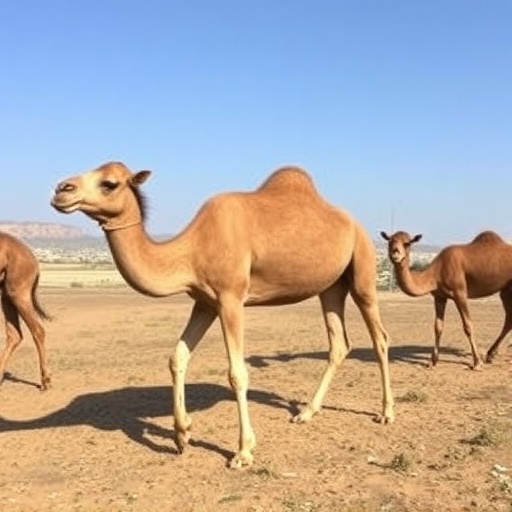In a groundbreaking study published in BMC Complementary Medicine and Therapies, researchers delved into the potential health benefits of camel whey protein and its hydrolysate against the parasite responsible for trichinellosis, a debilitating disease caused by the consumption of undercooked meat from infected animals. This innovative research unravels the dual role of camel whey protein, serving both preventive and curative functions in the context of parasitic infections, specifically targeting the dynamics of trichinellosis.
Trichinellosis is caused by the ingestion of larvae from Trichinella spiralis, which can lead to severe muscular pain, fever, and various systemic complications. Current treatment options are limited and often involve supportive care or antiparasitic medications with varying degrees of effectiveness. The rising incidence of foodborne illnesses worldwide emphasizes the urgent need for novel preventive strategies, and this study aims to fill that gap by exploring the application of camel whey protein.
Camel whey protein is a remarkable source of bioactive compounds, rich in immunoglobulins, lactoferrin, and lactoperoxidase, which are known to exhibit antimicrobial and immunomodulatory properties. The researchers conducted an extensive evaluation of the efficacy of both native camel whey protein and its trypsinized hydrolysate against Trichinella larvae. The study’s results are promising, indicating that these compounds could bolster the immune response and inhibit the proliferation of the parasite within the host, thereby paving the way for new therapeutic avenues.
The research team employed various experimental approaches, including in vitro and in vivo models, to assess the impact of camel whey protein on the immune response to infection. They observed enhanced activation of immune cells, particularly T lymphocytes, which play a crucial role in combating parasitic infections. The modulation of the immune system was notably pronounced when the trypsinized hydrolysate was utilized, suggesting that enzymatic modification may enhance the bioavailability and efficacy of the beneficial components within the whey protein.
The study further identified specific peptides within the hydrolysate that demonstrated significant antiparasitic activity. These peptides appear to disrupt the parasite’s lifecycle and inhibit its ability to establish infections. The researchers also emphasized the antioxidant properties of camel whey protein, which may mitigate oxidative stress induced by the parasitic infection, providing a dual mechanism of action: both attacking the parasite directly and supporting the host’s defenses.
Throughout the course of the research, the team maintained rigorous standards for experimental design and data analysis. They ensured that their findings are robust and reproducible, accommodating a spectrum of variables to simulate real-world conditions. The implications of this research extend beyond just medicinal applications; they open avenues for integrating camel whey protein into food products aimed at preventing parasitic infections in at-risk populations.
The study does not merely present theoretical insights; it cultivates a narrative around the potential for a dietary approach to combat trichinellosis, suggesting that incorporating camel whey protein into diets, particularly in endemic regions, could serve as an effective prophylactic measure. This dietary inclusion could be particularly beneficial in rural areas where access to advanced medical treatments may be limited.
The implications of this research echo in public health and nutritional policy arenas. If validated through subsequent clinical trials, the integration of camel whey protein could represent a significant shift towards using natural products to manage and prevent parasitic infections. Furthermore, it underscores the importance of traditional knowledge and practices regarding camel milk and its by-products, which have been utilized for centuries in various cultures for their health benefits.
However, as with all research that dives into uncharted territories, the path ahead holds multiple challenges. The researchers caution that factors such as individual variations in immune response, the need for large-scale human trials, and the logistical aspects of sourcing and processing camel whey protein must be critically evaluated. Translating laboratory findings into real-world applications requires an interdisciplinary approach, engaging nutritionists, microbiologists, and public health experts.
Moreover, there is an essential dialogue to be had about sustainable sourcing and the ecological impact of increasing demand for camel by-products. Responsible farming methods and ethical processing practices must accompany any initiatives aimed at leveraging these powerful natural resources. The researchers have laid a foundation for further inquiries that will not only expand upon these findings but also address the environmental and social dimensions of introducing camel whey protein into broader health strategies.
In conclusion, this research instigates a re-examination of the tools available to combat parasitic diseases and illustrates the untapped potential residing in nature’s offerings. With further studies validating these findings, the notion of utilizing camel whey protein as both a therapeutic and prophylactic agent could transition from hypothesis to reality, offering a beacon of hope in the continuous battle against infectious diseases.
As the scientific community and public health policymakers reflect on this research, it encourages a broader exploration of how naturally derived food products can enhance human health and combat disease. The integration of traditional knowledge with scientific innovation can create robust strategies that may lead to healthier populations globally, thus addressing one of humanity’s most persistent challenges.
Subject of Research: Camel whey protein and its hydrolysate as preventive and therapeutic agents against trichinellosis.
Article Title: Evaluation of prophylactic and therapeutic activity of camel whey protein and its trypsinized hydrolysate against experimental trichinellosis.
Article References:
Abdel Salam, S.A., El-Attar, A., Abdelaziz, M. et al. Evaluation of prophylactic and therapeutic activity of camel whey protein and its trypsinized hydrolysate against experimental trichinellosis.
BMC Complement Med Ther 25, 331 (2025). https://doi.org/10.1186/s12906-025-05083-7
Image Credits: AI Generated
DOI: 10.1186/s12906-025-05083-7
Keywords: Camel whey protein, trichinellosis, immunomodulatory, antiparasitic, dietary intervention, public health.
Tags: antimicrobial effects of camel wheybioactive compounds in camel milkcamel milk bioactive compoundscamel whey protein health benefitscamel whey protein research studyfoodborne illness preventionhydrolysate efficacy in trichinellosisimmunomodulatory properties of whey proteinnovel treatments for parasitic infectionsnutritional therapies for trichinellosisTrichinella spiralis infectiontrichinellosis prevention strategies





